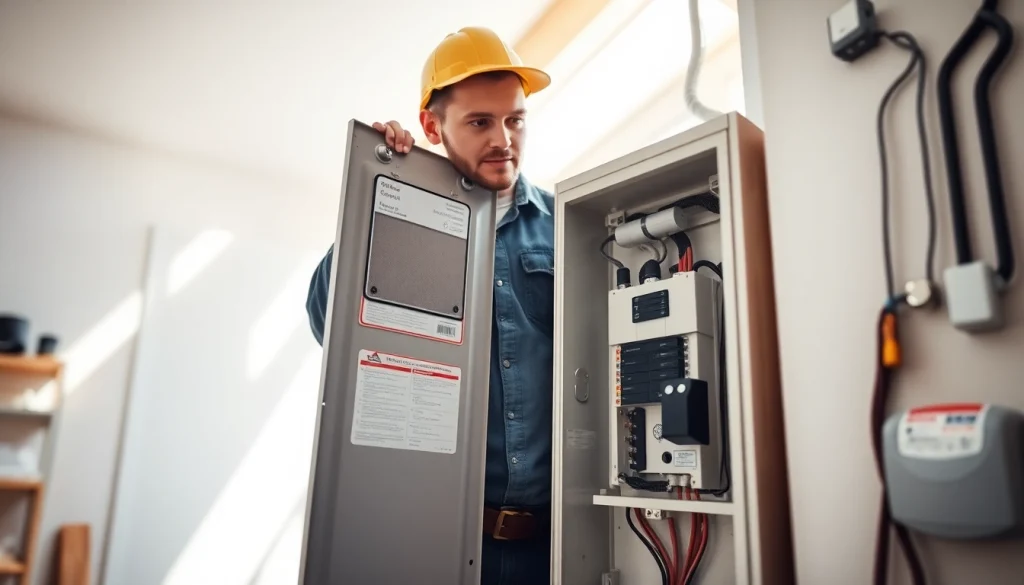1. What is an Electrical Panel Upgrade?
1.1 Definition and Purpose
An electrical panel upgrade refers to replacing or enhancing your home’s existing electrical panel to improve its performance and capacity. The electrical panel, also known as the breaker box or distribution board, is a vital component of your home’s electrical system, distributing electricity from the utility service to various circuits throughout the house. Upgrading may involve increasing the amperage, modernizing to meet current codes, or expanding capacity to accommodate new appliances and technologies.
1.2 Common Reasons for Upgrading
There are several reasons homeowners might consider an electrical panel upgrade, including:
- Increased Electrical Demand: As homes incorporate more electronic devices, appliances, and systems (such as electric vehicle chargers), an old panel may not support the increased load.
- Outdated Panels: Older models often lack the safety features found in modern panels, making them less efficient and potentially hazardous.
- Home Renovations: If you’re expanding your living space or adding new appliances, an upgrade ensures enough electrical capacity for your new features.
1.3 Safety Improvements through Upgrades
One of the most critical aspects of upgrading your electrical panel is improved safety. Modern panels are designed with enhanced safety features such as:
- Breaker Protection: Newer electrical panels use circuit breakers that protect against overloading, helping to prevent electrical fires.
- Ground Fault Protection: GFIs in upgraded panels offer an additional layer of protection against electric shock.
- Surge Protection: Upgrade panels often come with internal surge protection, reducing damage from electrical surges.
2. Key Indicators That You Need an Electrical Panel Upgrade
2.1 Signs of Overload
Recognizing when your electrical panel is overloaded is essential. Signs include:
- Frequent tripped breakers or blown fuses.
- Dim lights when running multiple devices.
- Warmth or buzzing sounds coming from the panel.
2.2 Requirements for Modern Appliances
Today’s appliances, including HVAC systems, electric stoves, and washer-dryer combos, have higher power requirements than older models. If you’re installing new heavy-duty appliances, you may need a panel that supports higher amperage, typically 200 amps for modern households.
2.3 Inspection and Code Compliance Needs
Local building codes dictate that electrical systems must be safe and up to current standards. If your home fails an inspection or you’re planning to sell, an upgrade may be necessary to meet compliance and enhance resale value.
3. The Cost of an Electrical Panel Upgrade
3.1 Breakdown of Expenses
The cost of upgrading an electrical panel varies widely, but here’s a general breakdown:
- Labor Costs: Professional electricians typically charge between $50 and $120 per hour. Depending on the project’s complexity, labor can account for a significant portion of your budget.
- Panel Cost: The electrical panel itself can cost between $100 and $500, depending on the amperage and features.
- Permits and Inspections: Local permitting costs can vary; ensure to account for these in your total cost.
3.2 Factors Influencing Cost
Several factors can influence the overall expense of an electrical panel upgrade:
- Location: Costs can vary by region due to labor rates and material costs.
- Amperage Rating: Higher amperage panels tend to be more expensive.
- Additional Work Required: If wiring or circuit modifications are needed, additional costs will apply.
3.3 Financing Options Available
Homeowners may need assistance covering the costs of an upgrade. Here are some financing options:
- Home Equity Loans: Tap into your home’s equity for financing.
- Low-Interest Personal Loans: Consider personal loans from banks or credit unions.
- Tax Credits and Rebates: Investigate local programs that offer tax incentives for electrical upgrades.
4. Steps to Prepare for an Electrical Panel Upgrade
4.1 Finding a Qualified Electrician
The first step in preparing for an electrical panel upgrade is finding a qualified electrician. Look for licensed, insured, and experienced professionals. Reading reviews and asking for referrals from trusted sources can help ensure you select the right team for your upgrade.
4.2 Initial Assessments and Quotes
Once you’ve found an electrician, they will perform an initial assessment of your current electrical system. This evaluation will help determine:
- Your current electrical load and usage.
- What amperage and type of panel you will need.
- The overall condition of the existing wiring and circuits.
Following the assessment, they will provide a detailed quote outlining the costs involved.
4.3 Planning for Downtime and Adjustments
During the upgrade, you may experience downtime when your power is turned off. Planning for this disruption involves:
- Identifying essential appliances that will require alternate arrangements.
- Establishing a timeline with your electrician to minimize downtime.
- Communicating with family members about scheduled outages to avoid inconvenience.
5. Long-Term Benefits of an Electrical Panel Upgrade
5.1 Increased Home Value
Investing in an electrical panel upgrade can increase your property’s market value. Homes with modern electrical systems are more attractive to prospective buyers and can lead to higher offers, especially in competitive real estate markets.
5.2 Enhanced Safety Features
Upgrading your electrical panel significantly enhances safety in your home. New panels come equipped with modern safety features that reduce the risk of electrical shocks, fires, and damaged appliances, protecting both your family and property.
5.3 Energy Efficiency and Savings
Modern panels can improve the energy efficiency of your electrical system, leading to long-term savings on utility bills. By accommodating new energy-efficient devices and technology, you’ll reduce overall energy consumption while maximizing savings.
In conclusion, an electrical panel upgrade represents an essential investment for homeowners looking to enhance safety, capacity, and efficiency within their electrical systems. Understanding the signs that necessitate an upgrade, preparing for the process, and recognizing the long-term benefits are key aspects that empower homeowners to make informed decisions in this critical area of home maintenance.
